At 5 am this morning, we entered the Caribbean Sea, passing between St. Lucia and Martinique. From there it is one straight North Westerly course towards the Ponce Pilot station. I have set a 6 am pilot station time for tomorrow, so we can be docked by 7 am to facilitate the clearance of the ship. When in Puerto Rico, American Immigration rules apply again and that means that they will have to see at least all non American citizens. Also as the crew has not been to the States in the 90 day clearance bracket; all crew has to see the Custom and Border Protection (CBP) officials as well and that will take some time. So while the ship sailed to the North West the purser’s department was sending multiple files to the CBP for the pre clearance to ensure that it will all go smoothly tomorrow morning.
I promised a few days ago to tell a bit more about the engine room. Now the chief has repainted most of the areas, after all the dry dock work that took place, it is once again an Engine room to be proud of. So today a little tribute to those unsung heroes, you seldom see, or notice, except when the water stops or the lights go out.
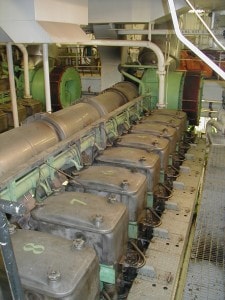 Overview over the top of Main engine Nbr 4. Wartsila sulzer type 8 ZAL 40S with the 8 standing for 8 cylinders.
Overview over the top of Main engine Nbr 4. Wartsila sulzer type 8 ZAL 40S with the 8 standing for 8 cylinders.
The Prinsendam is pushed through the water by two propellers of 4 blades each which are connected to two engines via a gear box. The diameter of each propeller is 4.8 m or 16 feet. The diameter of the propeller shaft is 0.5 meters or 20 inches. When all four engines are clutched in onto the shaft a maximum of 4 x 7181 HP can be delivered and that translates in a maximum sea speed of 21 knots. If we need less speed, we run less engines and the ship can run on one engine on one shaft if needed. Then there are two bow thrusters of each 1300 HP and they get their electricity from one of the two shaft generators which are also connected to the gear boxes. Each shaft feeds one bow thruster. We also have a stern thruster, which is an azipod. (That means it can turn 360o) of also 1300 HP. and that is run by the starboard shaft. Then there are three auxiliary engines of each 4600 HP and they provide the electric power for the ship.
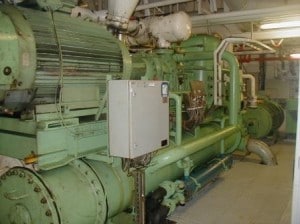 One of the four AC units located in the engineroom.
One of the four AC units located in the engineroom.
To control the temperature in the cabins and public rooms, we have four AC units which are providing chilled water with a temperature of 7 C. This cold water is pumped to all the different fan units in the ship. A fan unit consists of a cooler and a fan; the cold water goes in the cooler and the fan blows the air through the cooler and then to the cabins or public rooms. The power for these AC sets comes from those auxiliary engines. The ship is also equipped with two steam boilers and 5 auxiliary boilers that provide steam for heating (AC is not only about cold) and makes the hot potable water for use in the ship. Steam heats also the fuel which has to be warmed up to approx. 135o C before it can be used in the diesel engines. A lot of this steam goes to the potable water evaporators and the kitchens.
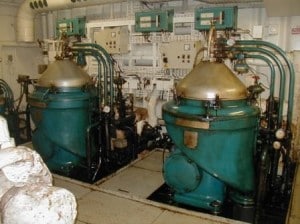 The oil purifiers. These are a sort of centrifuge where the heavy fuel oil gets cleaned, water removed, that might still be in the oil, before the heated fuel is injected into the engines.
The oil purifiers. These are a sort of centrifuge where the heavy fuel oil gets cleaned, water removed, that might still be in the oil, before the heated fuel is injected into the engines.
The engine room is setup as follows from bow to stern starting on deck 2, which runs the length of the ship, bordered by tanks forward and aft: Hydrophore room (pump room 1), Pump room 2 – (pipe tunnel) AC compressor room, Evaporator (sb/ps) and Oil purifier room and Maine engine room (houses the four main engines, the two gear boxes and the two shaft generators.)
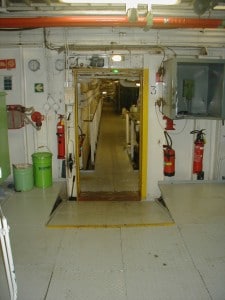 Looking forward through pump room nbr 2.
Looking forward through pump room nbr 2.
Then one deck up, deck 3, there is the Boiler room, the Auxiliary engine room and the work shops. Finally on deck four there is the Engine Control room, the Plumber store, day service workshop and the recycling centre where all the garbage is processed, recycled and or burned in the incinerator.
Functions that exist in the engine department: Officers: Chief Engineer, First Engineer (non watch standing) 2nd, 3rd, 4th and Asst engineers. 3rd Engineer day service, Chief Electrician, 2nd & 3rd electrician, Foreman Engine, Wiper, Fireman/greaser, Lampoonist (for changing light bulbs etc.) Machinists, Plumbers, Day Service Technician, Refrigeration Technician. Engine Mechanic (see also the blog of March 16) Special Service Technician (=Spare part administration) Plumbers, Foreman Waste Handler and Waste Handlers. In total 48 persons who keep the Prinsendam running smoothly and in good technical shape.
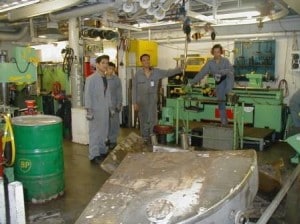 Some of the engine room staff in action. Here they are disassembling part of an old tank that has been replaced enroute.
Some of the engine room staff in action. Here they are disassembling part of an old tank that has been replaced enroute.
As a ship cannot stop every day at a repair shop when something breaks down, a lot of technical parts are carried onboard, or even constructed by our own personnel. The more modern the ship, the bigger the challenge as with modern electronics, there are more and more items, such as print boards, that you cannot repair yourself at all. Also you cannot carry a spare for each component onboard. Hence one of the challenges is to order a spare part timely so that is it is onboard when needed.
Most of the engine work takes place behind the scenes and many repairs are never noticed by the guests onboard. Only when for a short while one of the services has to be shut down, (potable water, AC or toilets) people realize that not everything comes by itself. We always try to avoid this but things do happen, same as ashore. As a captain I have to totally trust the engineering department when I maneuver the ship. Sometimes I have to work on the edge of what the Prinsendam can deliver, as an example when we were maneuvering through the ice in Antarctica or leaving with wind force 9 from the Falklands. If the engineers are then not ready to deliver, what I need, then things can become dangerous. But they always do and thus we can sail on a safe ship going around the world.
With a thank you to Chief Engineer Jaap Wisse for reviewing this blog.
Tomorrow we will be in Ponce, located on the Southside of Puerto Rico. It is a new and upcoming port and hence a reason for the Prinsendam to go there.

March 22, 2010 at 2:20 pm
Captain – Thank you for the tour of your engine spaces. Makes me thankful that I only have a small 6 cylinder Diesel in my small 34′ boat. However I don’t have your crew to help maintain all the systems. Enjoy your upcoming holiday!
March 22, 2010 at 5:21 pm
Captain Albert
Another fasinating look behind the “crew only” door. Thanks for opening it just a crack for us!
Regards
Roger T
March 22, 2010 at 8:55 pm
Captain Albert:
Thanks for the engine room emphasis today. Too bad that visits to the engine room have been discontinued these days due to safety/security reasons, and fear of litligation.
As a young boy on the 5,000 ton ms. Willemstad (KNSM) going from Amsterdam to Aruba in 1951 in a mere 3 weeks, I remember spending all my time “helping” either in the engine room or on the bridge. It was wonderful, I became a degreed mechanical engineer later.
Today ships have all the “behind the scenes” tours for women, such as the theater backstage (yechh) or the kitchen (yechh), but nothing for the guys.
I often think they should build future engine rooms with a corridor at ceiling level with glass windows into the engine room, and “talkie” stations so people could get an idea what exactly is moving this huge ship along along with other fhysical plant functions.
Anyway..thanks, I follow your blog religiously…….Ruud Hartog
March 23, 2010 at 7:26 pm
Wooaah, Captain! Thank you for your crash course tour through the bowels of your ship. I’ll be quiet from now on. Perhaps with the many dry dock (and other) pictures I can try to stitch the parts described together and leave the details for some other time (–in the near future–?)
All the different kinds of Olympics are now behind us and fortunately nothing drastic had occurred. Ah, to live in a world without distresses.
BTW, I hope you have no ambitions to become a bus driver!